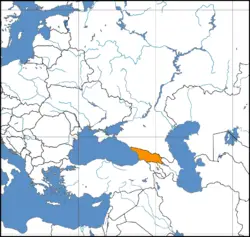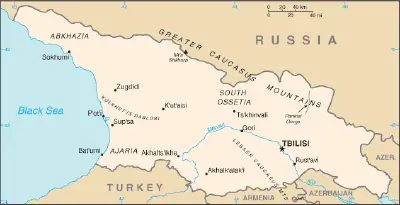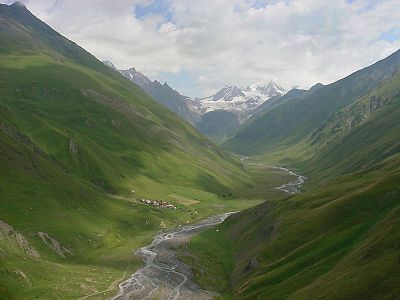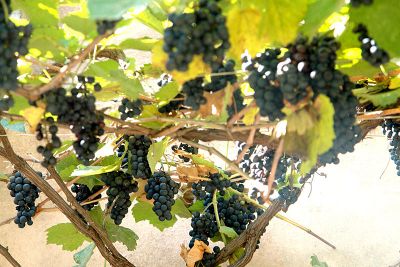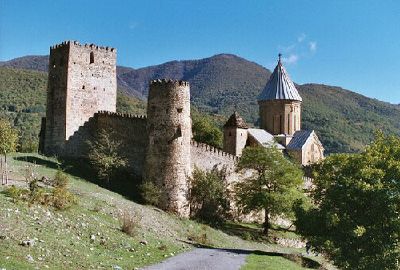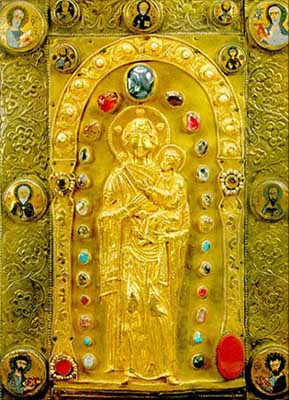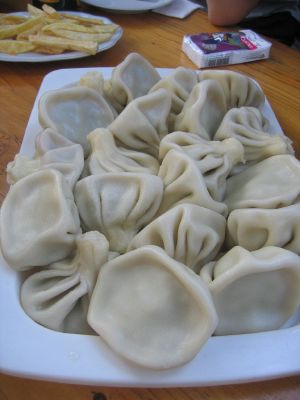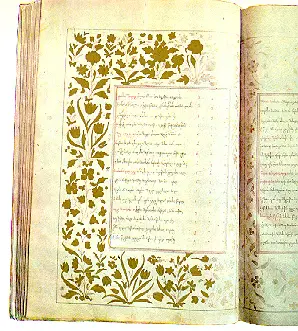This article is about the nation of Georgia. For the U.S. state, see Georgia (U.S. state).
| áĄáá„áá ááááá Georgia | |||||
| |||||
| Motto: Dzala ertobashia á«ááá áá ááááášáá (Georgian) "Strength is in Unity" | |||||
| Anthem: Tavisupleba áááááĄáŁá€áááá (Georgian) "Freedom" | |||||
| Capital | 41°43âČN 44°47âČE | ||||
|---|---|---|---|---|---|
| Largest city | capital | ||||
| Official languages | Georgian (also Abkhaz within the Abkhazian Autonomous Republic) | ||||
| Government | Unitary semi-presidential republic | ||||
| Â - President | Mikheil Kavelashvili | ||||
| Â - Prime Minister | Irakli Garibashvili | ||||
| Consolidation | Â | ||||
|  - Kingdoms of  Colchis and Iberia |
c.2000 B.C.E. | ||||
|  - Georgian Kingdom  unified |
1008 C.E. | ||||
|  - Democratic  Republic of Georgia |
May 26 1918Â | ||||
|  - Independence | from the Soviet Union | ||||
| Â - Declared | April 9, 1991Â | ||||
| Â - Recognized | September 6, 1991Â | ||||
| Â - Completed | December 25, 1991Â | ||||
| Area | |||||
|  - Total | 69,700 kmÂČ (120th) 26,911 sq mi | ||||
| Population | |||||
| Â - 2024 estimate | |||||
| Â - 2014 census | |||||
|  - Density | 57.6/kmÂČ 149.1/sq mi | ||||
| GDP (PPP) | 2024 estimate | ||||
| Â - Total | |||||
| Â - Per capita | |||||
| GDP (nominal) | 2024 estimate | ||||
| Â - Total | |||||
| Â - Per capita | |||||
| Currency | Lari (á) (GEL)
| ||||
| Time zone | MSK (UTC+3) | ||||
|  - Summer (DST) | MSD (UTC+4) | ||||
| Internet TLD | .ge | ||||
| Calling code | +995 | ||||
| 1 Population figure excludes Abkhazia and South Ossetia. | |||||
Georgia (transliterated as Sakartvelo), known officially from 1990 to 1995 as the Republic of Georgia, is a country to the east of the Black Sea.
Populated for about 8000 years, Georgia has been called the birthplace of wine, due to archaeological findings which indicate wine production back to 5000 B.C.E.
According to legend, the Georgian people descended from Biblical Noah's third son Japheth.
In 327 C.E., Christianity was declared the official state religion in the ancient Georgian Kingdom of Iberia, making Georgia the second oldest country after Armenia (301) to declare Christianity as the official state religion. The Bible was translated into the Georgian language in the fifth century.
From 1941 to 1945, during World War II, almost 700,000 Georgians fought as Red Army soldiers against Nazi Germany. A number fought with the German army. About 350,000 Georgians died on the Eastern Front.
Etymology
There is controversy over the etymology of the English name Georgia. One view holds that it is derived from the Greek: ÎΔÏÏγία GeĆrgĂa, meaning agriculture or farmland.
Another view contends that the English Georgia derives from the modern Persian word for the Georgians, گ۱ۏ۳ŰȘŰ§Ù or gurj, which means wolf. This term could derive from the helmet, made of a wolf's head, worn by the Georgian Vakhtang Gorgasali when he fought against invading Persians. This term could also originate from the once-held Persian belief that the pre-Christian Georgians worshipped a cult of the wolf.
Georgians call themselves Kartvelebi (á„áá ááááááá), their land Sakartvelo (áĄáá„áá ááááá), and their language Kartuli (á„áá ááŁáá). These names are derived from a chief named Kartlos, said to be the father of all Georgians. According to the legend Kartlos was a son of Targamos, grandson of Biblical Noah's third son Japheth.
Eastern Georgia was known by the Greek world as Iberia, which may be also be spelled as Iveria.
Geography
Georgia borders the Black Sea, between Turkey and Russia, in the Caucasus region, to the north and northeast, Georgia borders the Russian republics of Chechnya, Ingushetia, and North Ossetia, all of which began to seek autonomy from Russia in 1992. Neighbors to the south are Armenia, Azerbaijan, and Turkey. With a land area of 26,912 square miles, or 69,700 square kilometres, Georgia is slightly smaller than South Carolina, in the United States.
Mountains are the dominant geographic feature. The Likhi Range divides the country east and west. The western portion was known as Colchis while the eastern plateau was called Iberia. Mountains isolate the northern region of Svaneti from the rest of Georgia.
The Greater Caucasus Mountain Range separates Georgia from the North Caucasian Republics of Russia. The south is bounded by the Lesser Caucasus Mountains.
The highest mountain is Mount Shkhara at 17,059 feet (5201 meters) and the second highest is Mount Janga (Jangi-Tau) at 16,572 feet (5051 meters) above sea level. Other prominent peaks include Kazbek, Tetnuldi, Shota Rustaveli, Mount Ushba, and Ailama.
Only Kazbek is of volcanic origin. The region between Kazbek and Shkhara, a distance of about 124 miles (200km) along the Main Caucasus Range, is dominated by numerous glaciers. The Lesser Caucasus Mountains are made up of interconnected mountain ranges, largely of volcanic origin, that do not exceed 11,000 feet (3400 meters). The area includes the Javakheti Volcanic Plateau, numerous lakes, including Tabatskuri and Paravani, as well as mineral water and hot springs.
The Kazbek Cave, the deepest known cave in the world, is located in the Gagra Range, in Abkhazia. The cave is 7020 feet (2140 metres) deep. Main rivers include the Rioni and the Mtkvari.
Western Georgia's landscape ranges from low-land marsh-forests, swamps, and temperate rain forests to eternal snows and glaciers, while the eastern part of the country contains a small segment of semi-arid plains characteristic of Central Asia. Forests cover around 40 percent of Georgia's territory while the alpine/subalpine zone accounts for roughly around 10 percent.
Much of the natural habitat in the low-lying west has disappeared over the last 100 years due to the agricultural development and urbanization. Forests that covered the Colchis plain have gone with the exception of national parks and reserves (such as the Paleostomi Lake area).
Western Georgia's forests consist of deciduous trees below 1968 feet (600 meters) above sea level and include oak, hornbeam, beech, elm, ash, and chestnut. Evergreen species such as box may also be found in many areas.
Eastern Georgia's river plains have been deforested for agricultural purposes. Due to the region's drier climate, some low-lying plains were never forested. Nearly 85 percent of the forests are deciduous â including beech, oak, hornbeam, maple, aspen, ash, and hazelnut.
Climate
The climate of Georgia is diverse, considering the nation's small size. The Greater Caucasus Mountain Range keeps out colder air masses from the north, while the Lesser Caucasus Mountains partly protect the region from dry and hot air masses from the south.
Much of western Georgia lies within the humid subtropical zone, with annual precipitation ranging from 39â157 inches (1000â4000mm), heavy during autumn. While much of the lowland areas are relatively warm throughout the year, the foothills and mountainous areas have cool, wet summers and snowy winters. Ajaria is wettest, where the Mount Mtirala rainforest receives around 4500mm (177 inches) of precipitation per year.
The Black Sea port of Batumi receives 98.4 inches (2500 mm) per year. Several varieties of palm trees grow there. The midwinter average temperature is 41°F (5°C) and the midsummer average is 72°F (22°C).
Eastern Georgia has a transitional climate, from humid subtropical to continental. Annual precipitation ranges from 16â63 inches (400â1600mm). The wettest periods occur during spring and autumn. Summer temperatures range from 68°F (20°C) to 75°F (24°C), and winter temperatures from 35°F (2°C) to 40°F (4°C).
Concerns
Earthquakes and landslides in mountainous areas present a significant threat. Massive rock- and mudslides in Ajaria in 1989 displaced thousands in southwestern Georgia, and two earthquakes in 1991 destroyed several villages in northcentral Georgia and South Ossetia.
Black Sea pollution, caused by inadequate sewage treatment, has harmed Georgia's tourist industry. In Batumi, only 18 percent of wastewater is treated before release into the sea. An estimated 70 percent of surface water contains health-endangering bacteria to which Georgia's high rate of intestinal disease is attributed. The war in Abkhazia damaged ecological habitats unique to that region.
The main cities are the capital Tbilisi, with a population of 1,066,100, Kutaisi (183,300) and Batumi (116,900).
History
The region of presentâday Georgia was settled sometime between 6000 and 5000 B.C.E. by a neolithic culture. Archaeological excavations revealed a number of ancient settlements that included houses with galleries, carbon-dated to the fifth millennium B.C.E. in the Imiris-gora region of Eastern Georgia. In the the fourth and third millennia B.C.E., Georgia and Asia Minor were home to the Kura-Araxes culture, giving way in the second millennium B.C.E. to the Trialeti culture.
Between 2100 and 750 B.C.E., the area survived the invasions by the Hittites, Urartians, Medes, Proto-Persians and Cimmerians. At the same period, the ethnic unity of Proto-Kartvelians broke up into several branches, among them Svans, Zans, Chans and East-Kartvelians. Two core areas of future Georgian culture and statehood formed by the end of the eighth century B.C.E. In the west was the Kingdom of Colchis and in the east the Kingdom of Iberia.
Colchis is the location of the Golden Fleece sought by Jason and the Argonauts in the Greek myth and may have derived from the local practice of using fleeces to sift gold dust from rivers.
Adoption of Christianity
The western Georgian Kingdom of Iberia became one of the first states in the world to convert to Christianity in 327 C.E., when the King of Iberia, Mirian II, established it as the state religion. The date varies in the numerous accounts and historical documents. According to Georgian chronicles, St. Nino of Cappadocia converted Georgia to Christianity in 330 C.E. during the time of Constantine the Great. By the middle of the fourth century though, both Lazica (formerly the Kingdom of Colchis) and Iberia adopted Christianity.
During the fourth and most of the fifth centuries, Iberia (known also as the Kingdom of Kartli) was under Persian control. The Kingdom was abolished and the country was ruled by the governors appointed by the Shahs. At the end of the fifth century, Prince Vakhtang I Gorgasali orchestrated an anti-Persian uprising and restored Iberian statehood, proclaiming himself the king. Vakhtang launched campaigns against Persia and the Byzantine Empire. But after Vakhtangâs death in 502, and the short reign of his son Dachi (502-514), Iberia was reincorporated into Persia as a province with Iberian-elected governors, called erismtavari.
By the late seventh century, the Byzantine-Persian rivalry for the Middle East had given way to Arab conquest of the region.
Medieval
The rebellious regions were liberated and united into the Georgian Kingdom at the beginning of the eleventh century. This kingdom reached its zenith in the twelfth to early thirteenth centuries, and is termed as Georgia's Golden Age. But the kingdom was subordinated by the Mongols in 1236. Different local rulers fought for their independence until the kingdom disintegrated in the fifteenth century. Neighboring kingdoms exploited the situation and from the sixteenth century, the Persian Empire and the Ottoman Empire subordinated the eastern and western regions of Georgia, respectively.
Fighting between partly autonomous regions, rebellions, and Persian and Turkish invasions weakened the regions, reducing the population to 250,000 inhabitants at one point.
Within the Russian Empire
In 1783 Russia and the eastern Georgian kingdom of Kartli-Kakheti signed the Treaty of Georgievsk, according to which Kartli-Kakheti received protection by Russia. This, however, did not prevent Tbilisi from being sacked by the Persians in 1795.
On December 22, 1800, Tsar Paul I of Russia, at the alleged request of the Georgian king Giorgi XII of Kartli-Kakheti, signed the Proclamation on the incorporation of Georgia (Kartli-Kakheti) within the Russian Empire. In May 1801, Russian General Carl Heinrich Knorring dethroned the Georgian heir to the throne David Batonishvili and deployed a government headed by General Ivan Petrovich Lasarev. In April 1802, General Knorring forced the nobility, gathered in Tbilisi's Sioni Cathedral to take an oath on the imperial crown of Russia. Those who disagreed were arrested.
In the summer of 1805, Russian troops on the river Askerani near Zagam defeated the Persian army and saved Tbilisi from conquest. In 1810, Russia annexed the western Georgian kingdom of Imereti. The last Imeretian king and the last Georgian Bagrationi ruler Solomon II died in exile in 1815. From 1803 to 1878, as a result of Russian wars against Turkey and Iran, Batumi, Akhaltsikhe, Poti, and Abkhazia were annexed to Georgia. The principality of Guria was abolished in 1828, and that of Samegrelo (Mingrelia) in 1857. The region of Svaneti was gradually annexed in 1857â59.
The Soviet period
After the Russian Revolution of 1917, Georgia declared independence on May 26, 1918, in the midst of the Russian Civil War. The Georgian Social-Democratic Party won the election and its leader, Noe Zhordania, became the prime minister. In 1918 a GeorgianâArmenian war briefly erupted. In 1918â1919 the Georgian army attacked the Russian White Army to claim the Black Sea coastline.
In February 1921, the Russian Red Army defeated Georgia, the Social-Democrat government fled, and on February 25, the Red Army installed a puppet communist government led by Georgian Bolshevik Filipp Makharadze. Soviet rule was established only after a 1924 revolt was brutally suppressed. Georgia was incorporated into the Transcaucasian SFSR uniting Georgia, Armenia and Azerbaijan. The TFSSR was disaggregated into its component elements in 1936 and Georgia became the Georgian Soviet Socialist Republic.
The Georgian-born communist radical Iosif Dzhugashvili, better known by his nom de guerre Stalin (from the Russian word for steel), was to rise to the highest position of the Soviet state and rule ruthlessly.
From 1941 to 1945, during World War II, almost 700,000 Georgians fought as Red Army soldiers against Nazi Germany. A number fought with the German army. About 350,000 Georgians died on the Eastern Front. During this period, the Chechen, Ingush, Karachay and the Balkarian peoples from the Northern Caucasus, were deported to Siberia for alleged collaboration with the Nazis. With their respective autonomous republics abolished, the Georgian SSR was briefly granted some of their territory, until 1957.
A dissident movement began in the 1960s. The most prominent Georgian dissident was Merab Kostava, who was arrested several times and served a term in Soviet jail.
The Georgian Eduard Shevardnadze, the USSR's minister for foreign affairs, was one of the main architects of the Perestroika (economic restructuring) reforms of the late 1980s. During this period, Georgia developed a vigorous multi-party system that favored independence. The country staged the first multi-party parliamentary elections in the Soviet Union on October 28, 1990. From November 1990 to March 1991, one of the leaders of the National Liberation movement, Dr. Zviad Gamsakhurdia, was chairman of the Supreme Council of the Republic of Georgia.
Independence
The Georgian SSR was the first Soviet Republic to seek independence. Soviet troops killed several people at a peaceful demonstration in Tbilisi, on April 9, 1989, sparking an anti-Soviet movement similar to those of the Baltic republics. In the October 1990 elections to the Georgian Supreme Councilâthe first multi-party election in the USSRâthe Round TableâFree Georgia (RT-FG), formed around former dissidents Merab Kostava and Zviad Gamsakhurdia, won 155 out of 250 parliamentary seats, whereas the ruling Communist Party (CP) received only 64 seats.
On April 9, 1991, shortly before the collapse of the USSR, Georgia declared independence. On May 26, 1991, Zviad Gamsakhurdia was elected as first president of independent Georgia, but was soon deposed in a bloody coup d'Ă©tat. The country became embroiled in civil war that lasted almost until 1995.
In 1995, Eduard Shevardnadze was elected president of Georgia, and re-elected in 2000. Abkhazia and South Ossetia became embroiled in disputes with local separatists that led to widespread ethnic violence. Supported by Russia, Abkhazia and South Ossetia achieved de facto independence from Georgia. More than 250,000 Georgians were evicted from Abkhazia by Abkhaz separatists and North Caucasians volunteers, (including Chechens) in 1992-1993. More than 25,000 Georgians were expelled from Tskhinvali, and many Ossetian families were forced to move to Russia.
In 2003 Shevardnadze was deposed in the Rose Revolution, after Georgian opposition and international monitors asserted that the November 2 parliamentary elections were marred by fraud. Mikheil Saakashvili, Zurab Zhvania and Nino Burjanadze, former members and leaders of Shavarnadze's ruling party, led the revolution. Saakashvili was elected president in 2004.
On February 3, 2005, Prime Minister Zurab Zhvania died, in an apparent gas leak at the home of Raul Usupov, deputy governor of Kvemo Kartli region. Later, Zhvania's close friend and a long-time ally, Finance Minister Zurab Nogaideli was appointed for the post by President Saakashvili.
Government
The Politics of Georgia take place in the framework of a presidential representative democratic republic, with a multi-party system, and the president as head of government.
The executive comprises the president, who is both the chief of state and head of government for state security and defense, the prime minister, who is head of the remaining ministries of government, and a Cabinet of ministers. The president is elected by popular vote for a five-year term, and is eligible for a second term. An election was last held in January 2004 .
The legislature comprises a unicameral Supreme Council (commonly referred to as parliament) or Umaghiesi Sabcho, which has 235 seats, 150 of which are filled from party lists. Members are elected by popular vote to serve four-year terms. In the last elections, held in March 2004, the National Movement-Democratic Front took 67.6 percent of the vote, the Rightist Opposition 7.6 percent, and all other parties received less than 7 percent each.
Supreme Court judges are elected by the Supreme Council on the president's or chairman of the Supreme Court's recommendation. There is a Constitutional Court, and courts of first and second instance.
Military
Georgia's military is organized into land and air forces. They are collectively known as the Georgian Defense Forces (GDF). The mission and functions of the GDF are based on the Constitution of Georgia, Georgia's Law on Defense and National Military Strategy, and international agreements to which Georgia is signatory.
After its independence from the Soviet Union, Georgia began to develop its own military industry. The first exhibition of products made by STC Delta was in 1999. STC Delta now produces a variety of military equipment, including armored vehicles, artillery systems, aviation systems, personal protection equipment, and small arms.
Foreign relations
Georgia maintains good relations with its direct neighbors Armenia, Azerbaijan, and Turkey and participates in regional forums, such as the Black Sea Economic Council and the GUAM. During the Orange Revolution in Ukraine, thousands of Georgians rallied in support of Viktor Yushchenko in Kiev, Georgia's capital Tbilisi, and North America.
Georgia is working in becoming a full member of NATO. In August of 2004, the Individual Partnership Action Plan of Georgia was submitted officially to NATO.
On February 14, 2005, the agreement on the appointment of Partnership for Peace (PfP) liaison officer between Georgia and the North Atlantic Treaty Organization came into force, whereby a liaison officer for the South Caucasus was assigned to Georgia.
The United States influence in Georgia, notably through the "train and equip" military program and ensuing regular military support, along with the construction of the Baku-Tbilisi-Ceyhan pipeline, have made Tbilisiâs relations with Moscow frequently strained.
The Georgian and Russian people have a relationship which continues from the middle ages. Russia was a mediator in the Georgian-Abkhaz conflict, but Georgia is seeking direct dialogue. Russia has granted citizenship to many residents of Abkhazia and South Ossetia. Tbilisi regularly accuses Moscow of meddling in its internal affairs.
Administrative divisions
Georgia is divided into nine regions, two autonomous republics, and one city (k'alak'i). The regions are further subdivided into 69 districts (raioni). The two autonomous republics are Abkhazia and Ajaria. The status of South Ossetia, a former autonomous administrative district, also known as the Tskhinvali region, is being negotiated with the Russian-supported separatist government. Kodori Gorge is the only part of Abkhazia that remains under effective Georgian control.
Major cities are: Batumi, Chiatura, Gagra, Gori, Kutaisi, Poti, Rustavi, Sokhumi, Tbilisi, Tkibuli, Tskaltubo, Tskhinvali.
Economy
Agriculture and tourism have been Georgia's principal economic activities, due to the country's climate and topography. Georgians were rural people until the beginning of the twentieth century, when industrialization caused migration to urban areas, especially to the capital, Tblisi. For much of the twentieth century, Georgia's economy was governed by the Soviet command model. Since the fall of the USSR in 1991, structural reforms intended to enable a transition to a free market economy.
Georgia's main economic activities include cultivating grapes, citrus fruits, and hazelnuts; mining manganese and copper; and producing alcoholic and nonalcoholic beverages, metals, machinery, and chemicals. The country imports the bulk of its energy needs, including natural gas and oil products. It has sizeable but underdeveloped hydropower capacity.
Despite the severe damage the economy has suffered due to civil strife, Georgia, with the help of the IMF and World Bank, has made substantial economic gains since 2000, achieving positive GDP growth and curtailing inflation.
Georgia's economy is becoming more dependent on services, moving away from the agricultural sector.
After independence, much of the land owned by the state was privatized. Privatization has supplemented government expenditures on infrastructure, defense, and poverty reduction.
Smuggling remains a drain on the economy. Georgia suffers from energy shortages due to aging and badly maintained infrastructure, as well as poor management. Continued reform in the management of state-owned power entities is essential to successful privatization and sustainability in this sector.
Export commodities include scrap metal, machinery, chemicals; fuel reexports; citrus fruits, tea, wine. Export partners include Russia, Turkey, Azerbaijan, Turkmenistan, Bulgaria, Armenia, Ukraine, Canada, as well as several others.
Import commodities include fuels, machinery and parts, transport equipment, grain and other foods, and pharmaceuticals. Import partners include Russia, Turkey, Azerbaijan, Ukraine, Germany, United States, and several others.
Demographics
Ethnicity
Ethnic Georgians comprise the majority of the population. Others include Azeris, Armenians, Russians, Abkhazians, and Ossetians. Numerous smaller groups include Assyrians, Chechens, Chinese, Georgian Jews, Greeks, Kabardins, Kurds, Tatars, Turks and Ukrainians. Georgia's Jewish community is one of the oldest Jewish communities in the world.
Religion
Kartli (Iberia) adopted Christianity in 327 C.E., making Georgia the second oldest country after Armenia officially to become a Christian state. However, Christian communities existed in Egrisi (modern day Abkhazia) before St Nino preached Christianity. In addition, Jesus's Apostles, Simon and Andrew preached Christianity in Georgia, making the Georgian church Apostolic. It is referred to as the Georgian Orthodox and Apostolic Church. Georgian Orthodox Church gained its autocephaly (the status of a hierarchical church whose head bishop does not report to any higher-ranking bishop) in the fifth century during the reign of Vakhtang Gorgasali. The Bible was translated into Georgian in the fifth century. Today over 80 percent of the population practices the Georgian Orthodox Christianity.
The largest religious minority is Muslim.
Language
The official languages are Georgian and Abkhaz within the autonomous region of Abkhazia.
The Georgian language (also known as Kartuli) belongs to the Kartvelian (South Caucasian) language family. Some subgroups speak other languages in the same groupâLaz, Mingrelian, and Svan. The literary language comes from the Kartlian dialect spoken in the eastern kingdom of Kartli. Georgian is the only Kartvelian language that is written and taught, and is used by all Georgians.
The Georgian alphabet is said to have been invented in the fifth century B.C.E. and reformed by King Parnavaz I of Iberia in 284 B.C.E. However, most modern scholarship puts the date at some time in the fifth century C.E., when the earliest examples can be found.
Men and women
A Georgian woman is both breadwinner and housewife. Most urban women work when they can. Top-level jobs are less accessible for women, and few are in the government. Women are respected. They have the legal right to take the children after a divorce. Maternity leave is available. Women do most housework. Young educated women can get better-paid jobs than their fathers or husbands. Men and women may kiss on the cheek in public, but kissing on the lips and hugging in public are not approved. Shaking hands is common. Men may embrace in public. Women may not gaze at a stranger or smoke on the street.
Marriage and the family
Mutual attraction is the basis for marriage. In Muslim rural areas, some marriages are arranged, and some polygamy exists. There is a tendency for later marriage. Married people in a joint household have equal rights to their possessions.
In cities, the basic household is the nuclear family, although grandparents frequently live in and help to raise the children. In rural and mountainous areas, extended families exist, usually including several brothers with their parents and children.
If there is no will, property is divided among all the children, including daughters, or among the closest relatives if there are no children.
Children are the focus of the family, and attention is paid to their education and development. Kindergartens are less available, so retired grandparents often care for children. Boys are encouraged to be strong, and deal with cars or tools. Girls must be modest, good at housekeeping, sewing, and cooking, and are taught to play a musical instrument.
Education
The Georgian education system placed greater emphasis on Georgian language and history after independence in 1991. Education is free between the ages of six and 16. Tbilisi Ivane JavahiĆĄvili University, founded in 1918, is the main university. There are about 20 other university-level establishments. Higher education and a university diploma are highly valued. It is almost impossible to have a career without a diploma, although higher education is not always correlated with a higher income.
Class
There is a widening income gap between most people, and the new rich, who have benefited from privatization, trade, or corruption in the state bureaucracy. The new wealth is concentrated in Tbilisi, Batumi, and the Black Sea port of Poti. The Armenian and Jewish economic elite has lost its position because of emigration or because they maintain a lower profile. Wealth and success is expressed by a Westernized lifestyleâa Mercedes car, an apartment in a prestigious district, summer holidays in France, access to private European or American schools, or visiting casinos.
Culture
Georgia's medieval culture was greatly influenced by the Georgian Orthodox and Apostolic Church, which often sponsored the creation of works of religious devotion. These included churches and monasteries, icons, and hagiographies of Georgian saints. Many secular works of national history, mythology and hagiograpy were also written. During the modern period, from about the seventeenth century onwards, Georgian culture has been greatly influenced by European cultural imports. The State Museum of Georgia was founded in 1845. The Tbilisi State Theatre of Opera and Ballet was established a few years later, in 1851.
Georgian culture suffered under the rule of the Soviet Union during the twentieth century, during which a policy of Russification was imposed but strongly resisted. Since independence, a cultural resurgence has taken place, albeit somewhat hampered by the country's economic and political difficulties in the post-Soviet era.
Architecture
Rural settlements are dominated by a church. Many churches were destroyed or turned into storehouses in the Soviet period. Little remains of small medieval towns surrounded by a citadel wall. Urban architecture has a strong Soviet influence, with gloomy, pompous Government buildings and sculptures. The older quarters in some cities have an attractive mixture of European and Asian architecture. Most smaller towns are unplanned, overgrown villages.
Two-story stone buildings with large verandas typify rural architecture. Picturesque towers dominate villages. Traditional dwellings in the southern volcanic highlands lack windows, are set in the ground, and have polygonal narrowing ceilings with a central opening for light and the exit of smoke, above the central fireplace.
Monuments of Georgian Christian architecture include: The Georgian Church in Bethlehem (fourth century), the Church of Gavazi (fourth century) in Akhalsopeli, and Akaurta Church (fifth century) in Bolnisi district.
Cuisine
West Georgia has more hot and spicy vegetarian food, prepared with walnuts, tarragon, basil, coriander, feuille Grec, and pepper. Cheese made from cow's milk is eaten with corn bread or a corn and flour porridge. Khachapuri, a kind of cheese pizza, is common. Eastern food is heavier, with more mutton and pork. Wheat bread is preferred to corn, and sheep's cheese from Tusheti is popular. In the mountains, the most popular food is khinkali, a cooked meat dumpling that usually is accompanied by beer. Tomatoes, potatoes, radishes, pumpkins, eggplant, beans, cucumbers, and cabbage are popular. Tkemali sauce is made of wild plums.
Ground walnuts boiled in honey are served, along with a turkey or chicken in walnut sauce at New Year celebrations. An Easter meal includes hard-boiled eggs dyed red and other bright colors, roasted piglet and lamb, and cakes with vanilla and spices.
Wine
Grapes have been cultivated in the fertile valleys of South Caucasus for at least 7000 years, possibly the first area to do so. Many believe that the word "wine" is of Georgian origin. Between 7000 B.C.E. and 5000 B.C.E., people of South Caucasus discovered that wild grape juice turned into wine when it was left buried through the winter in a shallow pit.
Among the best-known regions of Georgia in which wine is produced are Kakheti (further divided into micro-regions of Telavi and Kvareli), Kartli, Imereti, Racha-Lechkhumi and Kvemo Svaneti, and Abkhazia.
Georgia ranks fourth in grape production in the former Soviet Union behind Russia, Ukraine, and Moldova, though Georgian wines have always been the most highly prized. Georgian wines have begun to be widely imitated and counterfeited.
Although there are nearly 500 Georgian grape varieties, only 38 varieties are grown commercially in Georgia. Rkatsiteli (white) ranks third in the world in hectares grown. It is high in acidity and is capable of producing wines with fine character. Saperavi (red) produces substantial deep red wines that are suitable for extended aging, perhaps up to 50 years. Saperavi has the potential to produce high alcohol levels and is used extensively for blending with other lesser varieties.
Chacha is a grape brandy traditionally produced in Georgia and Abkhazia, similar to pomace brandy. It is often described as grape vodka or Georgian vodka. It can be produced either from pomace or from non-ripe or non-cultured grapes. The term "chacha" is used in Georgia to refer to any type of moonshine made of fruits.
Art
Well-known Georgian painters were: Damiane (thirteenth century), Anania (fifteenth century), Mamuka Tavakarashvili (seventeenth century). The Tbilisi State Academy of Art was founded in 1917.
Music
Georgia has what may be the oldest continuous tradition of polyphonic music in the world, predating the introduction of Christianity.
Scales used in traditional Georgian music have, like most European scales, octaves divided into seven tones (eight including the octave), but the spacing of the tones is different, producing a compressed (compared to most European music) major second, a neutral third, and a stretched perfect fourth. Likewise, between the fifth and the octave come two evenly-spaced notes, producing a compressed major sixth and a stretched minor seventh. Because of the influence of the Western music and its different system of tuning, present-day performances of Georgian folk music often employ Western tuning.
Georgian folk songs are often centered on feasts called supra, where songs and toasts to God, fatherland, long life, love and other topics. Work songs are widespread. There is a rich tradition of Georgian sacred music, both settings of hymns for the Orthodox Church, and folk hymns and ritual songs that contain a great deal of pagan imagery. There are many lyric love songs, dance songs, lullabies, and travelling songs, among others.
Choirs are generally entirely male, though some female groups also exist; mixed-gender choirs are rare.
Folk music styles from different regions of Georgia differ very widely, which makes it difficult to speak of characteristics of "Georgian folk music" as a monolithic whole.
Table songs from Kakheti in eastern Georgia usually feature a simple, drone-like bass part with two soloists singing the top two parts. Kakhetian melodies sound like recitative part of the time (with great emphasis on the words, which are highly poetic), and then break into series of ornate, cascading ornaments.
In Rach'a and Ajara, male singers accompany themselves on bagpipe. Consonance and dissonance is prominent in the west, in Mingrelia and Guria, which also features high pitches and yodelling-like vocals called krimanchuli. Svaneti's traditions are perhaps the oldest and most traditional due to the region's isolation. Svan harmonies are irregular and angular, and the middle voice leads two supporting vocals, all with a narrow range. The twentieth century has seen professional choirs achieve renown in Georgia, especially Anzor Erkomaishvili's Rustavi Choir.
Georgia is home to a form of urban music with sentimental, lovelorn lyrics, as well as a more rough and crude urban music featuring clarinets, doli and wind instruments called duduks.
Dance
Georgia has a number of folk dances which have a number of purposes. The Kartuli dance reminds the audience of a wedding. The Khorumi is a war dance that originated in south-west Georgia. Thirty or 40 dancers can participate. The Acharuli dance, from the same region, is distinguished with its colorful costumes. Many Georgian dances are based on the idea of competition.
Literature
The first Georgian-language printing house was established in the 1620s in Italy and the first one in Georgia itself was founded in 1709 in Tbilisi.
Important Georgian literary works of the pre-Christian period are: Amiraniani, ancient Georgian folk epos of the end of the second millennium B.C.E., and âLife of the King Farnavaz (third century B.C.E., anon). Notable Georgian written works from the medieval period include: The Life of Saint Nino (fourth century, anon), The Life of the King Mirian by Abyatar (fourth century), The Martyrdom of Queen Shushanik by Iakob Tsurtaveli (fifth century), Corpus Areopagiticum, a philosophical and theological work attributed to Peter the Iberian (fifth century), Thou Art a Vineyard, a famous Georgian religious hymn by the King Demetre I Bagrationi (twelfth century), Vepkhistkaosani (The Knight in the Panther's Skin), a national epic poem by Shota Rustaveli (twelfth century), Kartlis Tskhovreba (History of Georgia), a collection of old Georgian chronicles (from ancient times to the fourteenth century).
Nineteenth century writers were: Nikoloz Baratashvili (poet), Alexander Orbeliani (writer), Vakhtang Orbeliani (poet), Dimitri Kipiani (writer), Grigol Orbeliani (poet), Ilia Chavchavadze (writer and poet), Akaki Tsereteli (poet), Alexander Kazbegi (writer), Rapiel Eristavi (poet), Mamia Gurieli (poet), Iakob Gogebashvili (writer), and Simon Gugunava (poet).
Theatre
Georgia's oldest theatrical form was the "Sakhioba" (extant from the third century B.C.E. to the seventeenth century C.E.). The Georgian National Theatre was founded in 1791 in Tbilisi, by the writer, dramatist and diplomat Giorgi Avalishvili (1769-1850). Its leading actors were Dimitri Aleksi-Meskhishvili, David Machabeli, David Bagrationi, Dimitri Cholokashvili and others.
Cinema
The first cinema in Georgia was established in Tbilisi on November 16, 1896. The first Georgian cinema documentary ("Journey of Akaki Tsereteli in Racha-Lechkhumi") was filmed in 1912 by Vasil Amashukeli (1886-1977), while the first Georgian feature film ("Kristine") was produced in 1916 by Alexandre Tsutsunava (1881-1955).
Sports
Football (soccer) is the most popular sport in Georgia. The Georgia national football team FC Dinamo is controlled by the Georgian Football Federation. The Georgian team's first match took place in 1990, while Georgia was still part of the Soviet Union. The team has attempted to qualify for each major tournament from 1996 UEFA European Football Championship onwards, but have not yet achieved qualification. Georgia's home games are played at the Boris Paichadze Stadium in Tblisi.
Rugby is considered the second most popular sport in Georgia, after football (soccer). It is especially popular in the south. This popularity took off after the Georgia Rugby Union's inception into the International Rugby Board, which made rugby union a major spectator sport. When Georgia played Russia in the European Nations Cup, 65,000 people crammed into the national stadium in Tbilisi and another 44,000 watched Georgia beat Russia 17-13.
Notable sports figures include Zaza Pachulia, a basketball player for the Atlanta Hawks, and Kaha Kaladze, a soccer player for AC Milan.
Notes
- â CIA, Georgia: People and Society The World Factbook. Retrieved February 28, 2025.
- â 2014 General Population Census Results National Statistics Office of Georgia. Retrieved September 4, 2023.
- â 3.0 3.1 3.2 3.3 title=World Economic Outlook Database, October 2023 Edition. (Georgia) International Monetary Fund. Retrieved February 28, 2025.
ReferencesISBN links support NWE through referral fees
- Anchabadze, George. History of Georgia: A Short Sketch. Tbilisi, 2005. ISBN 978-1140572138
- Braund, David. Georgia in antiquity: a history of Colchis and Transcaucasian Iberia, 550 B.C.E.- AD 562. Oxford: Clarendon Press, 1994. ISBN 0198144733
- Gvosdev, Nikolas K. Imperial policies and perspectives towards Georgia, 1760-1819. St. Antony's series. New York: St. Martin's Press in association with St. Antony's College, Oxford, 2000. ISBN 0333748433
- Lang, David M. The last years of the Georgian monarchy, 1658-1832. New York: Columbia University Press, 1957. OCLC 2682755
- Lang, David M. A Modern History of Georgia. Richmond: Curzon, 2001. ISBN 0700715622
- Karumidze, Zurab, and James V. Wertsch (eds.). Enough!: the Rose Revolution in the Republic of Georgia, 2003. New York: Nova Science Publishers, 2005. ISBN 1594542104
- Suny, Ronald G. The making of the Georgian nation. Studies of nationalities in the USSR. Bloomington: Indiana University Press in association with Hoover Institution Press, Stanford University, Stanford, CA, 1988. ISBN 0253336236
External links
All links retrieved February 28, 2025.
- Georgia Countries and Their Cultures.
- Georgia Eurasianet.
- Georgia The World Factbook.
- Georgia country profile BBC.
Credits
New World Encyclopedia writers and editors rewrote and completed the Wikipedia article in accordance with New World Encyclopedia standards. This article abides by terms of the Creative Commons CC-by-sa 3.0 License (CC-by-sa), which may be used and disseminated with proper attribution. Credit is due under the terms of this license that can reference both the New World Encyclopedia contributors and the selfless volunteer contributors of the Wikimedia Foundation. To cite this article click here for a list of acceptable citing formats.The history of earlier contributions by wikipedians is accessible to researchers here:
- Georgia history
- History_of_Georgia history
- Geography_of_Georgia history
- Politics_of_Georgia history
- Economy_of_Georgia history
- Demographics_of_Georgia history
- Culture_of_Georgia history
- Georgian_cuisine history
- Music_of_Georgia history
The history of this article since it was imported to New World Encyclopedia:
Note: Some restrictions may apply to use of individual images which are separately licensed.


